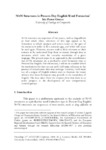Mostrar o rexistro simple do ítem
N+N Structures in Present-Day English Word Formation
| dc.contributor.author | Pastor Gómez, Iria | |
| dc.date.accessioned | 2016-07-15T08:35:27Z | |
| dc.date.available | 2016-07-15T08:35:27Z | |
| dc.date.issued | 2008 | |
| dc.identifier.citation | AEDEAN 2008, 31: 395-404 ISBN-978-84-9749-278-2 | |
| dc.identifier.isbn | 978-84-9749-278-2 | |
| dc.identifier.uri | http://hdl.handle.net/2183/17053 | |
| dc.description.abstract | [Abstract] N+N structures are sequences of two nouns, such as drug addiction or heart attack; often, structures of this type appear to be formations to which speakers and writers resort on the spur of the moment in order to fill a semantic gap, and which will never be used again. However, reasons such as their relevance or their easiness to be understood help them to remain through time as structures which enter the everyday vocabulary of a given language. The present paper is an approach to the consideration that N+N structures are a productive word formation type in Present-Day English. For this reason, I will try to establish which the motivations for their use are and I will make reference to the process of lexicalisation they may undergo. Likewise, I will make use of a corpus of English written texts to illustrate the lexical richness that these formations may provide to the vocabulary of English. The data taken from the corpora show that there is an active progress in the development of new compositional nominal groups. | |
| dc.language.iso | eng | |
| dc.publisher | Universidade da Coruña | |
| dc.title | N+N Structures in Present-Day English Word Formation | |
| dc.type | info:eu-repo/semantics/conferenceObject | |
| dc.rights.access | info:eu-repo/semantics/openAccess |






